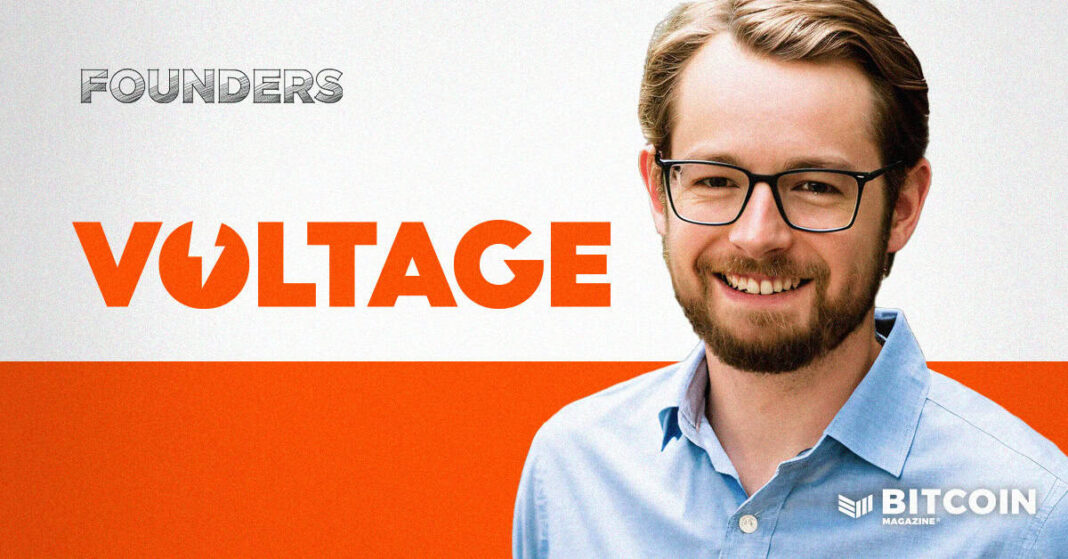Founder: Graham Krizek
Date Founded: October 2020
Location of Headquarters: Wichita, Kansas
Number of Employees: 17
Website: https://www.voltage.cloud/
Public or Private? Private
In 2012, soon after Graham Krizek discovered Bitcoin and subsequently began contributing to Bitcoin Core and building his own applications on Bitcoin, he noticed an issue that was hindering Bitcoin builders.
“The problem that I saw was that everyone was building everything from scratch — over and over and over again,” Krizek told Bitcoin Magazine. “There was no cloud environment where you could just spin up Bitcoin infrastructure and be able to start developing against it.”
At the time, Krizek didn’t feel compelled to act on this issue, though. He was still primarily focused on his career as a software engineer outside of the Bitcoin space, working for various startups as well as companies as large as Salesforce, while contributing to Bitcoin in his free time.
But something shifted within him when he learned about the Lightning Network.
He saw its potential and knew that it would have to be made easier to use if it were to be widely adopted.
“When I found Lightning, I said to myself ‘Okay, this is the next phase of Bitcoin adoption, the thing that’s going to really drive it to the next level,” said Krizek.
“Then, I saw the same pattern happening as I did with Bitcoin. Everyone kept starting from scratch while building, but the problems were more intense because Lightning is that much more complicated,” he added.
“I was like ‘We need a cloud provider where you can just click a button and have a Lightning node running and maintained for you.’ It can just be there so we can develop applications and build the projects we want to build much easier, much faster.”
And so Krizek got to work in creating such a product.
He shared the initial iteration of it with friends and acquaintances, many of whom began using it so much that the project demanded more of his attention.
“The usage grew to a point where I was like, ‘Man, I either need to shut this down because I can’t maintain it anymore or I need to turn this into a business and do it for real,’” said Krizek.
He decided on the latter, and by late 2020, he’d founded Voltage.
How Voltage Works
Voltage abstracts away the complexities of using Lightning by allowing users to deploy a Lightning node and spin up a channel in just a few clicks.
While Voltage hosts your node in its cloud, its public key, peers, channels, balance and transactions all remain private, as all of the traffic routed through the node is transferred via Tor.
While your node is running in the Voltage cloud, which is supported by the Google Cloud and several other cloud service providers, Voltage also helps users manage liquidity and offers other forms of customer support.
Essentially, Voltage abstracts away the difficulties of engaging with Lightning, while supporting its users in the process. And it does this in efforts to help institutions more readily adopt Lightning. Krizek also mentioned they have new products and capabilities to help even traditional finance companies with the integration.
“The mission of Voltage is to make Bitcoin and the Lightning Network accessible to every business on the planet,” said Krizek.
“Lightning is fantastic. It’s got a lot of really amazing capabilities, but it can be really hard to wrap your head around it and especially to incorporate it for business operations — especially for businesses that maybe aren’t in the Bitcoin or crypto space,” he added.
“We make it easy to use and plug in.”
What Types Of Companies Are Using Lightning?
In the past year, notable companies such as major crypto exchange Coinbase and Latin America’s largest fintech bank Nubank have incorporated Lightning into their operations.
Krizek sees this trend of crypto exchanges, neobanks and other financial service platforms onboarding to Lightning continuing in the year ahead.
“Finance companies are definitely going to be the biggest movers because if you can take the value of sub-second settlement with zero fees and apply that to a big payment processor that does global payments, it’s an incredible value add for their business,” said Krizek.
What is more, Krizek sees companies outside of the Bitcoin, crypto and finance space also beginning to utilize Lightning in 2025, in part, because companies like Voltage are making it easier to do so.
“2025 will be a big year for starting to branch out of our niche market,” said Krizek.
“The technology has still been a little rough around the edges for a big company like Walmart to be like, ‘Hey, we’re going to plug this in now.’ Even with Voltage, we haven’t been perfect the entire time with making Lightning super easy to use,” he added.
“I think we’ve made huge strides in the last like year, though, and we have a lot more coming out.”
Another major hurdle for companies looking to adopt Lightning is the risk that comes with managing bitcoin’s volatility.
But that risk doesn’t exist if companies send Tether (USDT) over Lightning instead of bitcoin, which they will be able to do soon.
Tether (USDT) On Lightning
Krizek is optimistic about USDT coming to Lightning, as he believes it will spur growth on the network.
“I think that we’re going to have a lot of products and solutions around it,” said Krizek.
“It’s not even just me being personally excited about it. A lot of our customer base is very excited about it. They’re asking for it directly from us because stablecoins are pretty much the biggest use case in crypto today,” he added.
“When you couple stablecoins with sub-second settlement fees and very low fees, that’s a huge unlock. With fees on Tron getting more expensive. People are looking for an alternative.”
(Tron has been the leading blockchain for stablecoin transactions because of how low fees on the network have been historically.)
As far as USDT running over Lightning potentially presenting a security risk to Bitcoin (as I think it does), Krizek doesn’t seem concerned.
“It doesn’t worry me at all,” said Krizek.
“I think that we’ve advanced since the Blocksize War in terms of takeovers, as I don’t think it’s as easy for a large institution to coerce the Bitcoin ecosystem like some did during the Blocksize Wars,” he added, referring to Tether potentially gaining outsized influence over Bitcoin.
“And it’s even better to integrate something like Tether (USDT) on Lightning because it’s a peer-to-peer network — it’s not public consensus. So, you have much more ability to say ‘Hey, if you don’t want to participate in the USDT transfers, just don’t do it.’”
Moving Forward In A Pro-Bitcoin Regulatory Environment
U.S. Crypto Czar David Sacks is an investor in Voltage (via his venture capital firm, Craft Ventures). This would indicate that he has some understanding of the Lightning Network and the role of bitcoin as a medium of exchange.
So, does this mean that the U.S. is on the verge of embracing bitcoin as such?
According to Krizek, not exactly.
“Everyone is screaming at the government right now for a Strategic Bitcoin Reserve, which treats bitcoin as a store of value,” explained Krizek.
“Over time, we will definitely hear more and more about bitcoin as a means of payment. We just need to get through this Strategic Reserve conversation first and then say, ‘Okay, what else can we do with this?’” he added.
The fact that the government is painting Bitcoin in any sort of positive light at all, though, is exciting to Krizek. Since 2012, when he first entered the Bitcoin space, the government has either dismissed Bitcoin or been antagonistic towards it.
“When I started in Bitcoin, it was completely ignored, and the last four years were very bad for companies like us,” said Krizek.
“With this new administration, we’ve definitely seen the tone shift. We’re still working through certain things, but we’re definitely turning a corner and heading in the right direction,” he added.
“I’m really excited to see where that can go over the coming year. I think it will be a positive one.”



